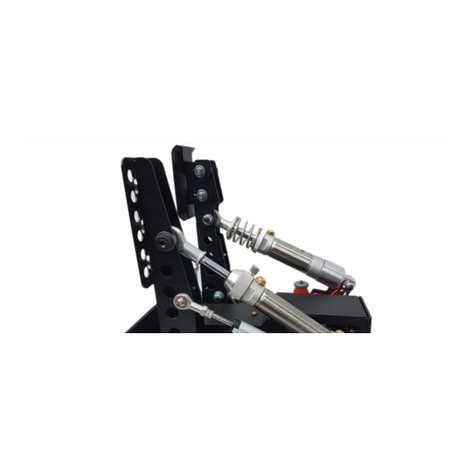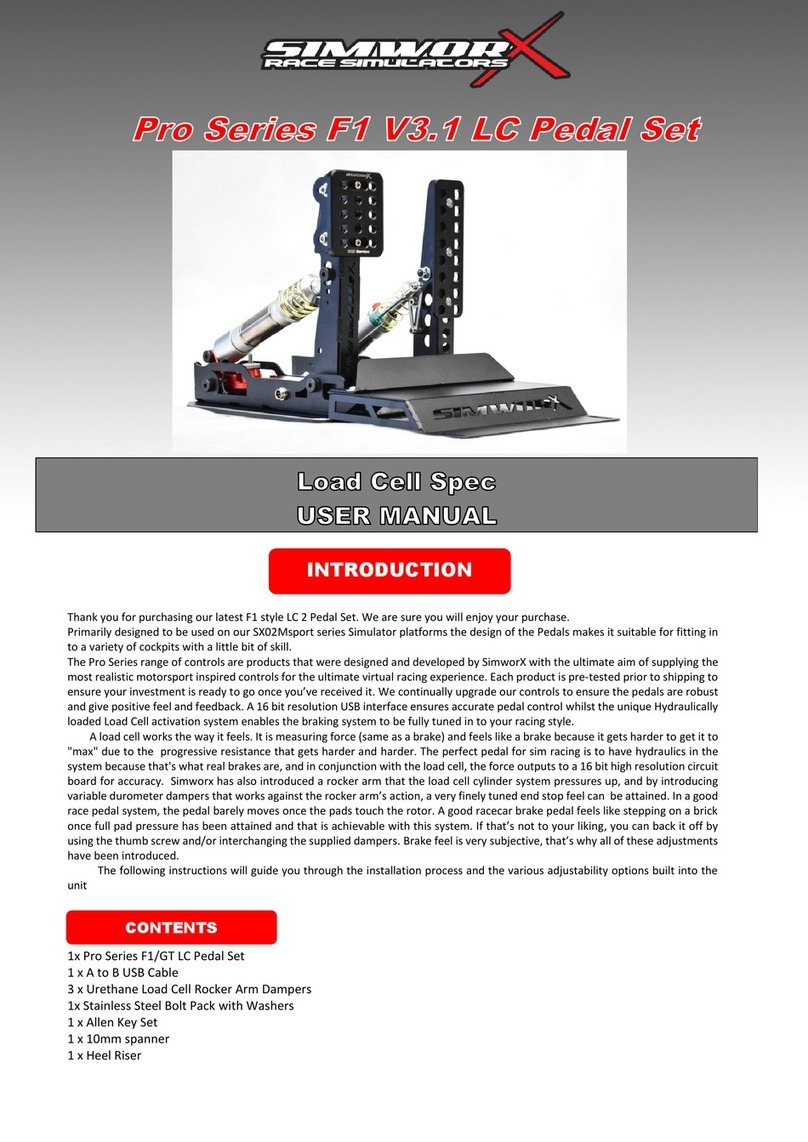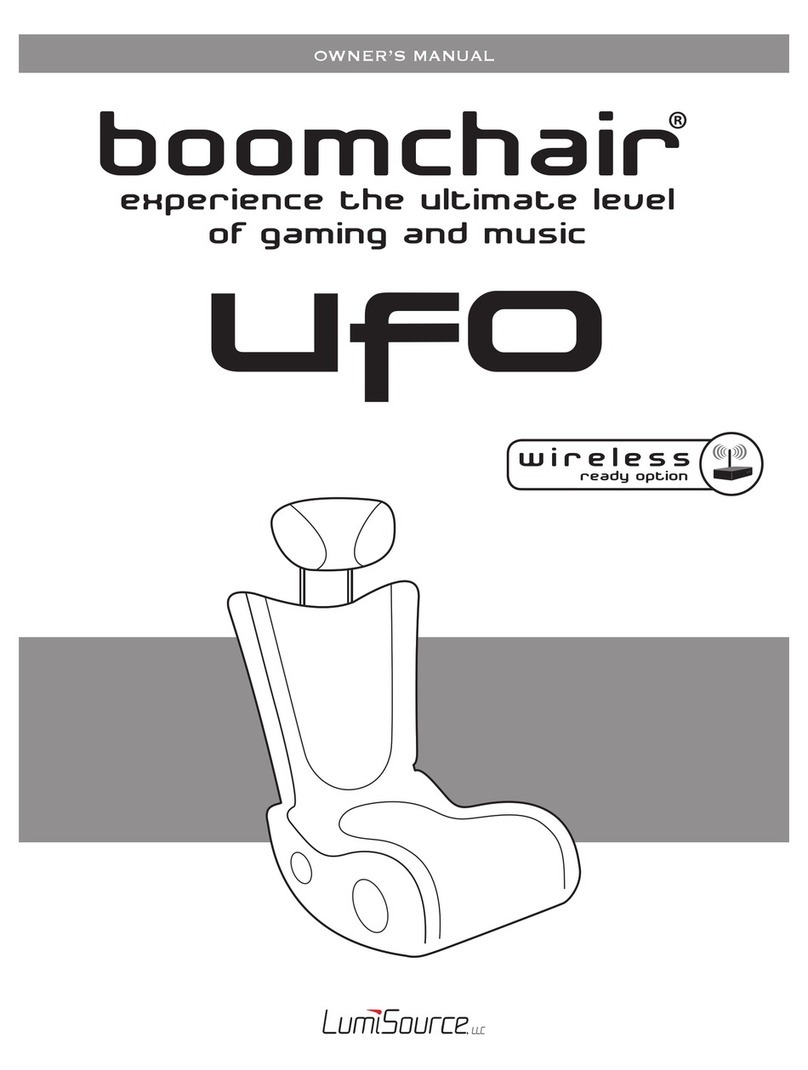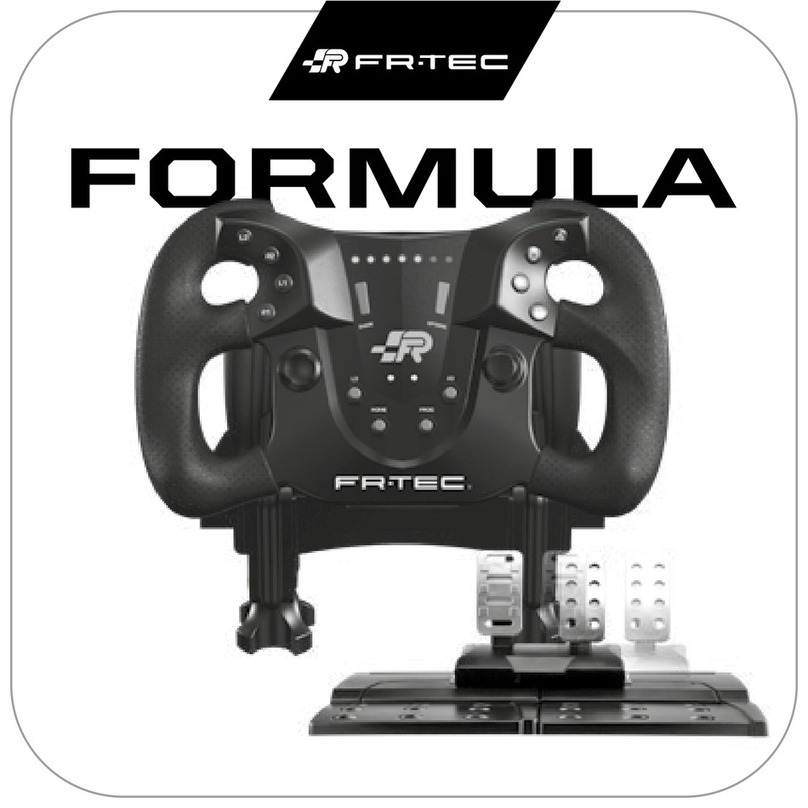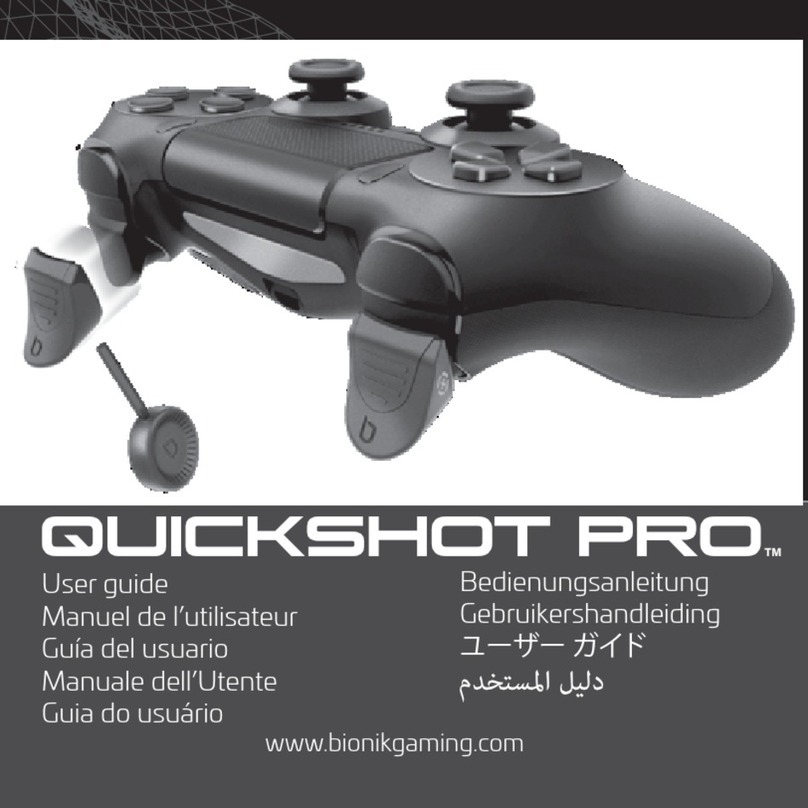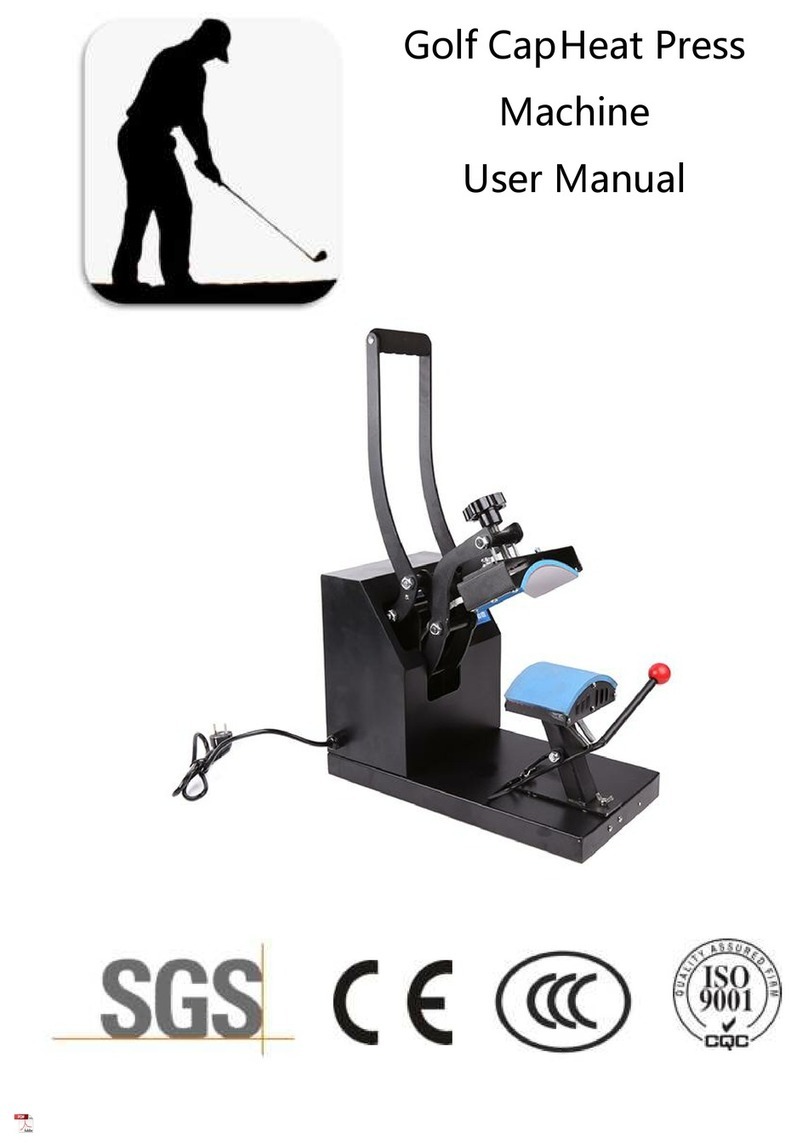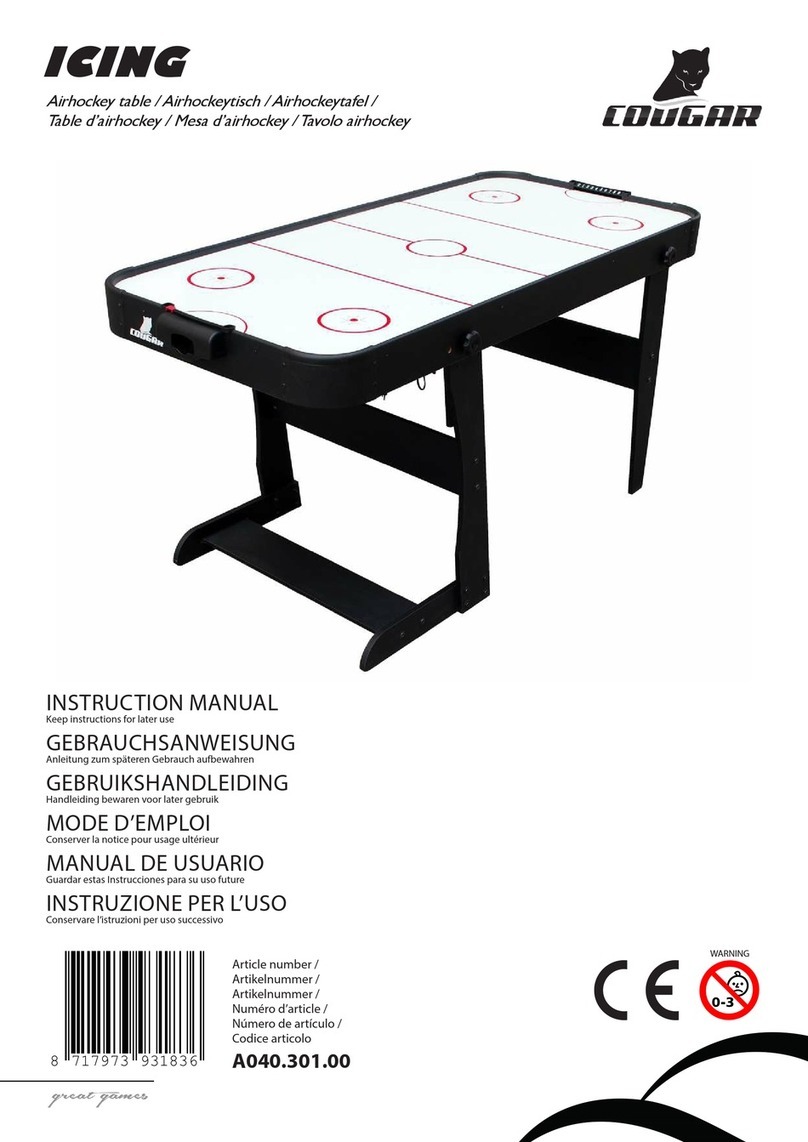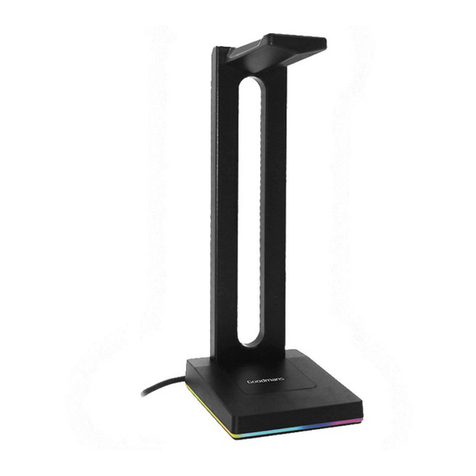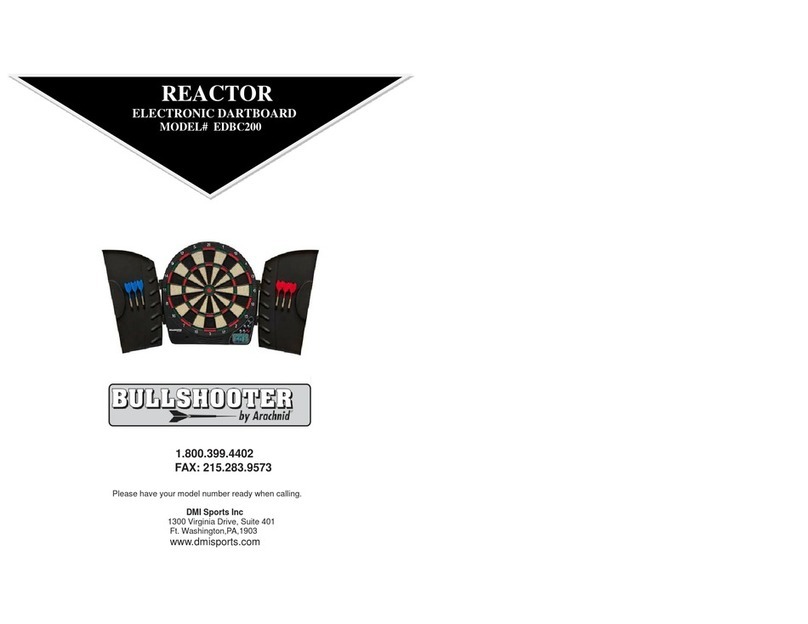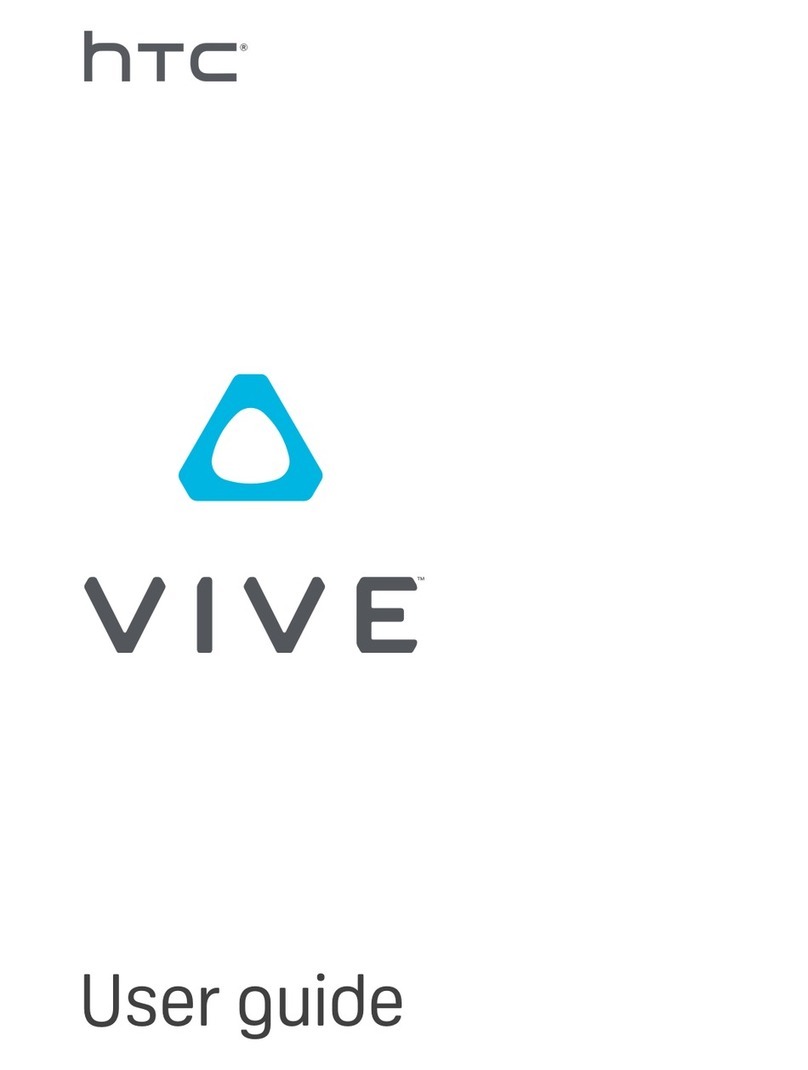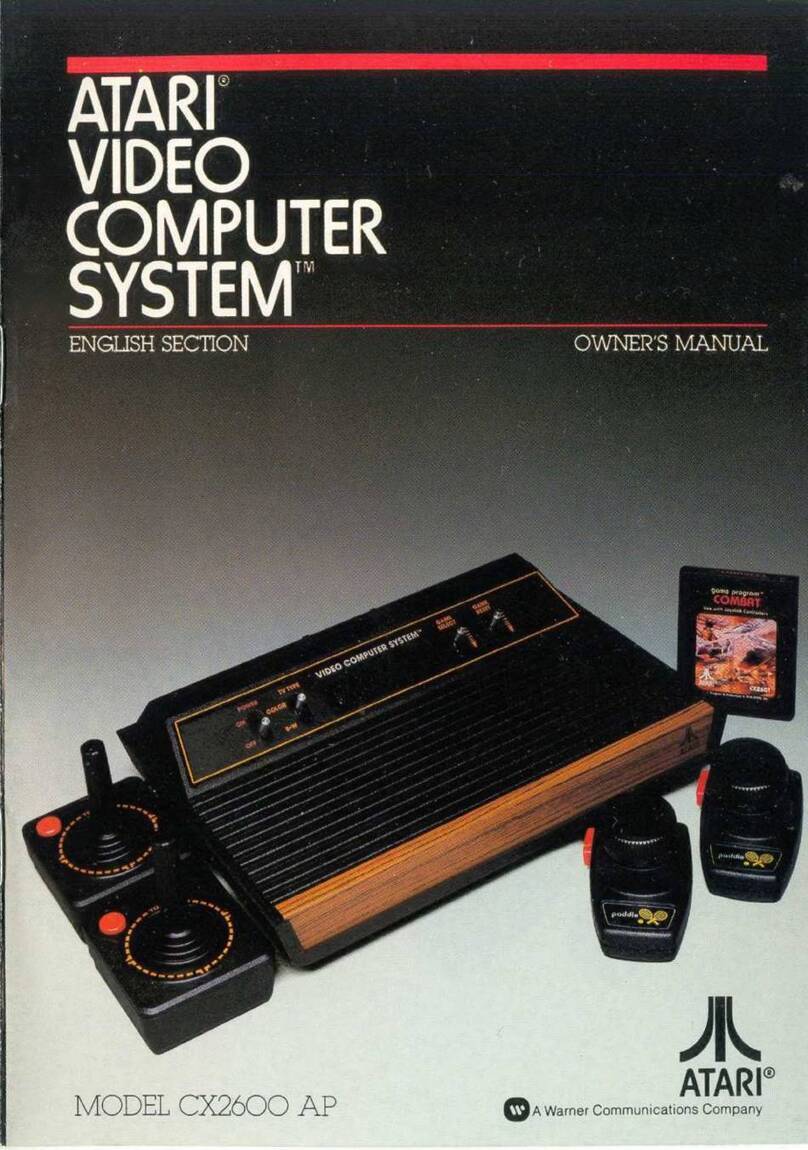SimworX Pro Series User manual

Thank you for purchasing our V3.1 LC Pedal Set. We are sure you will enjoy your purchase.
Primarily designed to be used on our SX02Msport series Simulator platforms, the design of the Pedals makes it suitable for fitting in
to a variety of cockpits with a little bit of skill.
There is the added capability of converting these pedals to an inverted position so the pedals hang down for those wanting to
replicate a specific car.
The Brake Pedal module can also be moved left and right on the base independent of the brake and clutch modules.
The Pro Series range of controls are products that were designed and developed by SimworX with the ultimate aim of supplying the
most realistic motorsport inspired controls for the ultimate virtual racing experience. Each product is pre-tested prior to shipping to
ensure your investment is ready to go once you’ve received it. We continually upgrade our controls to ensure the pedals are robust
and give positive feel and feedback. A 16 bit resolution USB interface ensures accurate pedal control whilst the unique Hydraulically
loaded Load Cell activation system enables the braking system to be fully tuned in to your racing style.
A load cell works the way it feels. It is measuring force (same as a brake) and feels like a brake because it gets harder to get it to
"max" due to the progressive resistance that gets harder and harder. The perfect pedal for sim racing is to have hydraulics in the
system because that's what real brakes are, and in conjunction with the load cell, the force outputs to a 16 bit high resolution circuit
board for accuracy. Simworx has also introduced a rocker arm that the load cell cylinder system pressures up, and by introducing
variable durometer dampers that works against the rocker arm’s action, a very finely tuned end stop feel can easily be attained. In
a good race pedal system, the pedal barely moves once the pads touch the rotor. A good racecar brake pedal feels like stepping on
a brick once full pad pressure has been attained and that is achievable with this system. If that’s not to your liking, you can back it
off by using the thumb screw and/or interchanging the supplied dampers. Brake feel is very subjective, that’s why all of these
adjustments have been introduced.
The following instructions will guide you through the installation process and the various adjustability options built into the
unit
1x Pro V3.1 LC Pedal Set
1 x Heel Riser with adjustable heel rest
1 x A to B USB Cable
3 x Urethane Load Cell Rocker Arm Bushes
1x Stainless Steel Bolt Pack with Washers
1 x Allen Key Set
1 x 10mm + 8mm spanner
INTRODUCTION
PACKAGE CONTENTS

For owners of existing Simworx simulators and/or chassis units, the mounting points for the pedals and heel plates are already
in place. Locate the pedals and with the supplied bolt set insert them in to the pre-tapped bolt holes. .
For fitting to other simulators, make sure the frame is strong enough to withstand the forces you can exert on the brake pedal.
This is extremely important. If there is too much flex you need to reinforce the mounting surface. It is recommended to run
support braces in line with the pedal base slots and one across the front of the pedal base to fully support it.
Below you will find a drilling guide for your Pedals base plate. Position the pedal set plate at your preferred location and using
the slots either side of the base plate, carefully mark the hole position through the pedal base slots onto your mounting surface. As
a rule we usually recommend marking the mounting bolt holes halfway in the slots so you can move its position backwards and
forwards to your requirements.
Once you are satisfied with its location, drill a small pilot hole at each bolt location. Finish the hole size at 8.5mm
Bolt the pedal set in place using the supplied bolts and washers in the bolt pack. Fasten the slot bolts and adjust the pedal position
incrementally until you are satisfied with its final position.
Please make sure they are secured tightly to ensure that the pedal set doesn’t flex under the pressure. The mounting surface
needs to be strong enough to withstand the 120kgs+ of pressure that can be exerted on the brake pedal.
Finally, fit the heel plate if your rig allows it, it sits on the front extensions over the front edge of the pedal set base and is
bolted in place with 6mm Stainless Steel screws and washers.
V3 Pedals Base Plate and Heel Riser Dimensions Aviation Plugs
FITTING
Inverting The Pedals
Pedal Modules can be removed
from the base so you can swap
over the clutch and accelerator
modules and invert the pedals
for those that want the pedals
hanging down.
First remove the two aviation
plugs from the Brake Pedal
Module, undo the 4 socket
screws located in the corner of
the throttle and clutch modules,
swap the module positions over
and re-insert and tighten the
screws. Plug the sockets back in
the Brake Pedal module.
Fasten Heel Riser with
6mm Cap Screws
The Brake pedal can be moved L&R

Plug in the supplied USB A to B cable into the centre of the brake pedal module and then into a spare USB port on your
computer. The pedal set should be automatically be detected by Windows and self-install. You can confirm this by going to the
‘devices and printers” and confirming that “Simworx Pro Series” is listed there. If it’s not listed, try another USB port on the
computer end.
This procedure is based on the windows 7/8.1/10 operating system, older systems may vary.
1. Once you have connected your pedals and the “Simworx Pro Series” device is visible in windows “Devices and Printers”, right click on the
“Simworx Pro Series” and select “Game Controller Settings
2. From the next list, select “Simworx Pro Series” and click the “Properties” button.
3. Click the “Settings” tab in the next window.
4. Click “Reset to default”
5. Click “Calibrate”
6. Follow the on screen prompts to calibrate your device
7. Once completed, you will be taken to the testing window, press all the pedals and watch the visible red sliders to confirm calibration, if the
red sliders do not travel the full extent, repeat from step 3.
Once correctly calibrated in Windows you can run your game and configure your in game controls.
You may find that when assigning the brake pedal in the game, you may notice a flickering on the calibration bar due to a slight pre-load tension on
the load cell. This is related to what you have set the pedal position and rocker arm damper tension to. Adding a touch of Dead Zone to the brakes
will eliminate that initial static pre-load.
Calibrating in IRacing
If you are having an issue calibrating the Brake Pedal in iRacing try the following steps.
As iRacing doesn’t have a Dead Zone adjustment in their calibration window we will need to do this mechanically, due to the Load Cell’s sensitivity.
Follow these steps:
1. Before you start calibrating, tighten the damper adjuster one turn
2. Calibrate brake pedal as normal
3. After Calibration back off the Damper adjuster one turn to where you started.
In most cases that adjustment is all that is necessary.
( If there is still a slight brake input showing in the calibration bar, repeat the above steps but tighten the damper adjuster 2 turns first, calibrate as
normal and back it off 2 turns after calibration)
CONNECTION
CALIBRATION
ADJUSTMENTS
Pedal Face Angle
The pedal face on both the clutch and brake pedals are fitted with angle and height adjustments. To adjust, using a 5mm allen key and
10mm spanner, loosen off the two nuts (pointed out by the red arrows) a few turns to loosen the pad assembly. Once loose, you will be
able to adjust the pad upwards & down, as well as tilt the pedal face backward and forwards until you’re comfortable with the position.
The Brake Pedal Pad can also be moved side to side to you desired position using the supplied Hex Allen Key
Once you’re satisfied with the position, tighten up the bolts firmly to ensure that the pad does not move under load

Thumbwheel
Loosen Tighten
Pedal Rebound Adjustment
Please Note:
After any Pedal Rebound adjustments, you will need to go through the calibration process again.
SimworX Simulators
Victoria, Australia 3140
Loosen Tighten
Brake Pedal Feel
The pedals come with urethane dampers which have different durometers and heights that act on the Load Cell Cylinder Rocker Arm.
The Red is the “soft” damper and the Black is the “Hard” damper. The thumbwheel enables the pedal feel to be infinitely adjustable.
As standard, the soft grade damper (RED) is fitted. The short red damper will give you a more solid feel, the short and long black
dampers will give you a much harder pedal end feel. To change the dampers, if needed, is a very simple process as outlined below..
Pedal Set Points are adjusted via the screw stops at the base of the pedals using the 5mm Allen key and a 10mm spanner.
The brake assembly can be adjusted for brake stroke /
tension. With four settings. Soft, Medium Soft, Hard &
Medium Hard. Each setting changes the amount of braking
force & travel of the pedal. You will be supplied with 4
Urethane dampers. Our default damper is the soft (RED)
which is fitted as standard and the medium soft (Short red)
and the two Black hard dampers are supplied with your
pedals.
The softest damper set (RED) provides the most travel and
softest feel, whereas the hard damper (BLACK) sets
provides a short travel with a very firm pedal. You can also
adjust the feel with the thumb wheel by screwing it in and
out. To fit the alternative damper, unscrew the thumb
wheel and replace the damper. Replace the thumbwheel
and screw down to the required feel..
The Heel support
mounted on the riser
can be adjusted
forward and back to
suit a driver’s
preferred position
Brake and Throttle Tensioner Ring
The brake cylinder is fitted with a dedicated spring tensioner
(A)for adjusting the initial preload to the brake pedal to mimic
the initial pad travel to the brake rotor.
This is useful for fine tuning that initial pedal travel.
If required, to adjust, hold the brake cylinder and spin the
tensioner ring at the base of the brake spring. Once the
tensioner ring starts to feel tight to turn, you have reached the
maximum tension point. Do not try and force the tensioner ring
further .
The Throttle Cylinder has an adjuster to adjust tension
and/or throw of that pedal. Unscrew the thumbscrew (B) rotate
the adjuster (C) to the desired position and replace the thumb
screw to lock.
The stroke on the throttle Pedal typically can be adjusted from
a minimum of 60mm to a maximum of 90mm
A
B
C
Clutch Pedal Tension
Clutch pedal tension can be adjusted using the
knurled adjuster on the lower clutch throw arm.
This manual suits for next models
1
Table of contents
Other SimworX Video Gaming Accessories manuals
Popular Video Gaming Accessories manuals by other brands
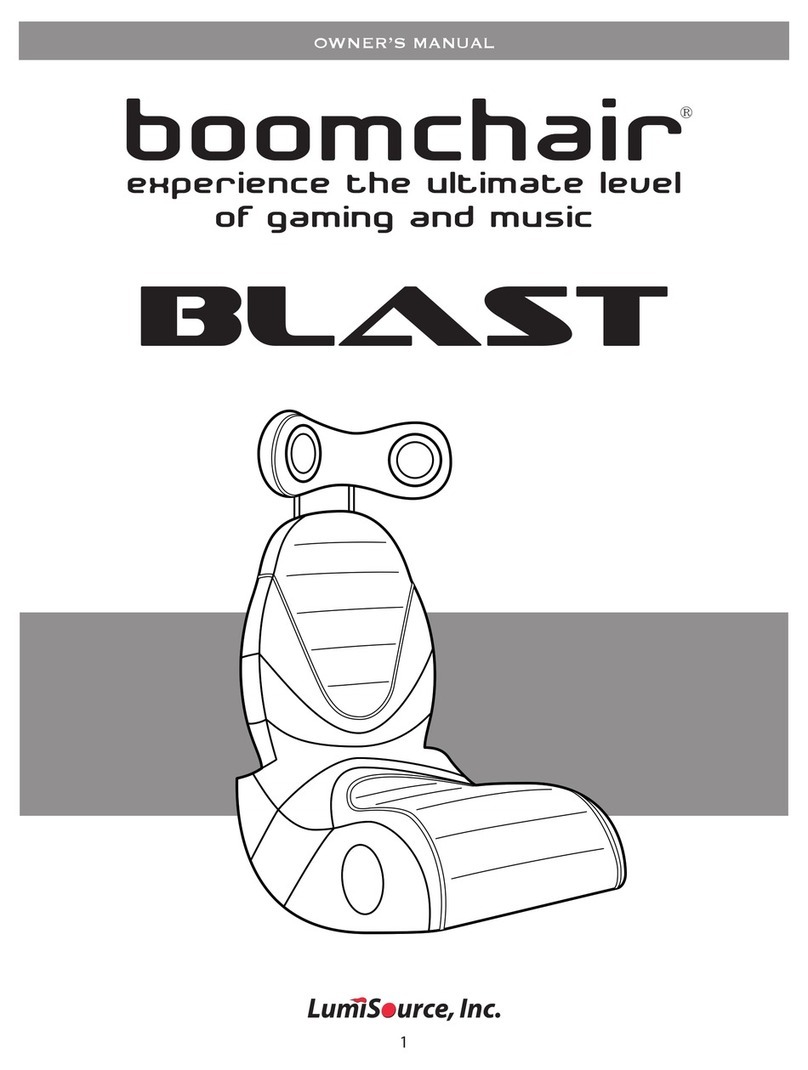
LumiSource
LumiSource Video Game Furniture owner's manual
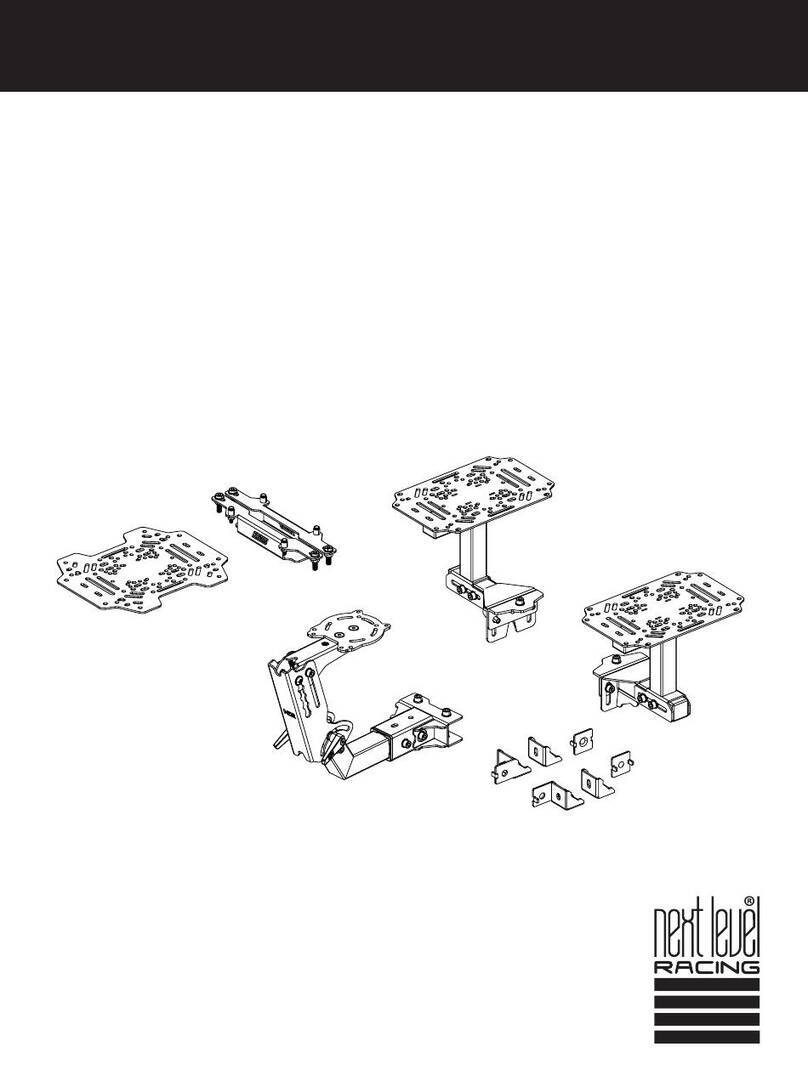
Next Level Racing
Next Level Racing ELITE FLIGHT PACK instruction manual
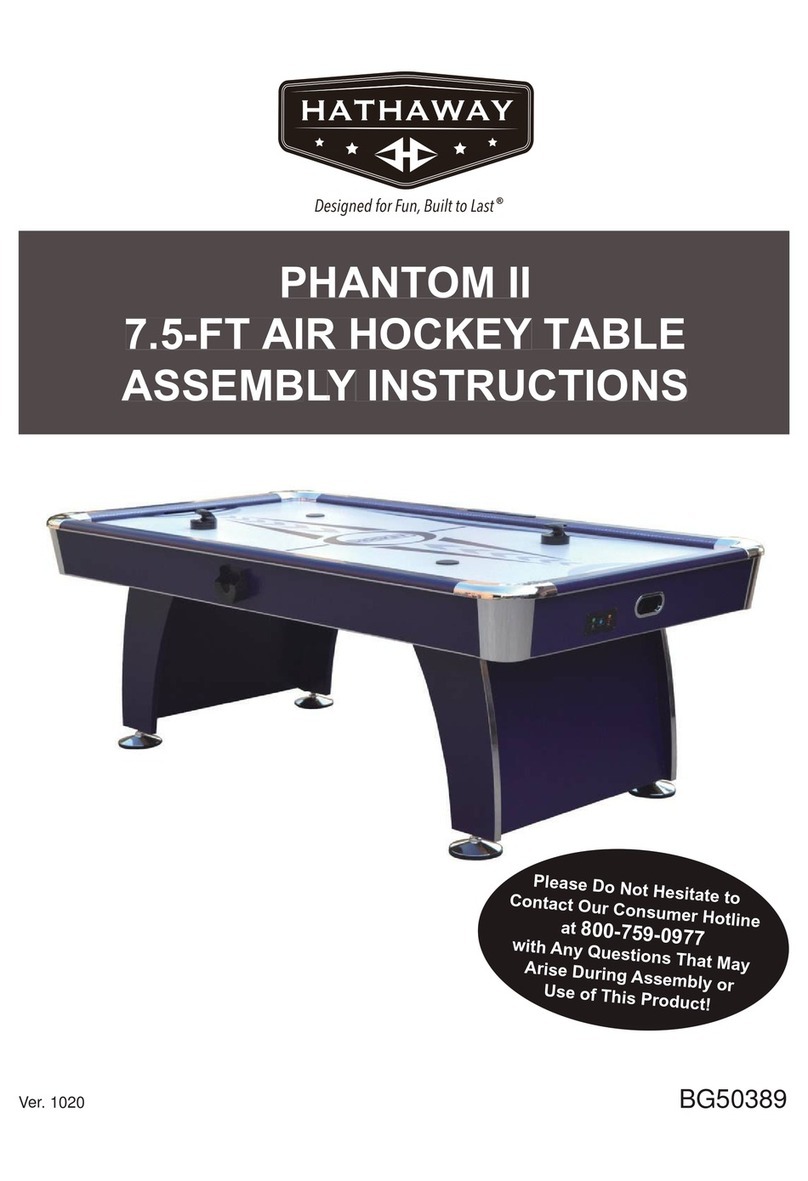
Hathaway
Hathaway PHANTOM II BG50389 Assembly instructions
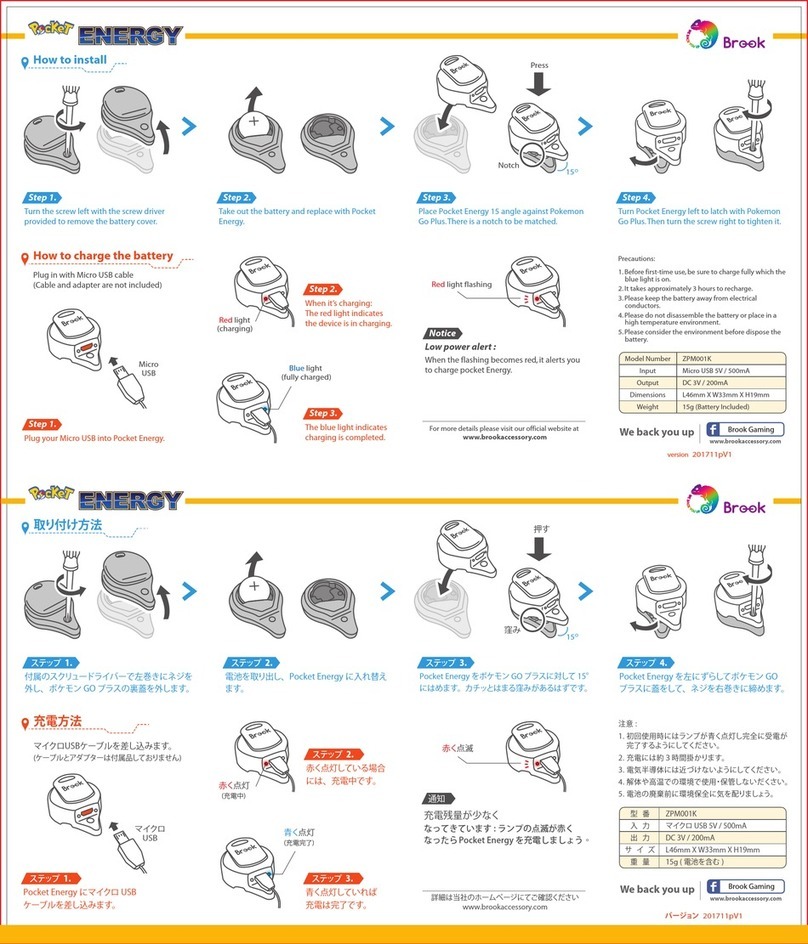
Brook
Brook POCKET ENERGY quick start guide
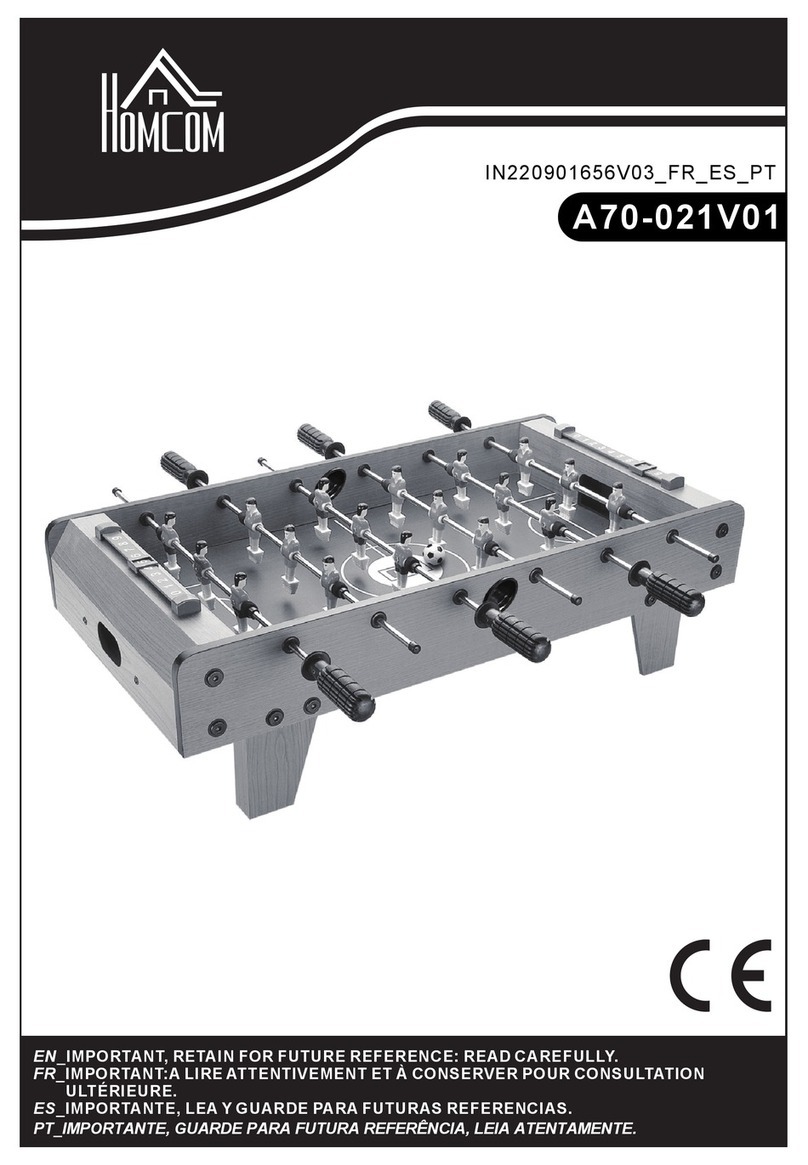
HOMCOM
HOMCOM A70-021V01 manual
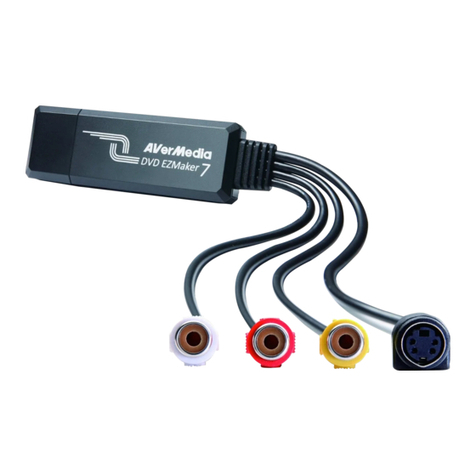
Avermedia
Avermedia DVD EZMaker 7 C039 quick guide
